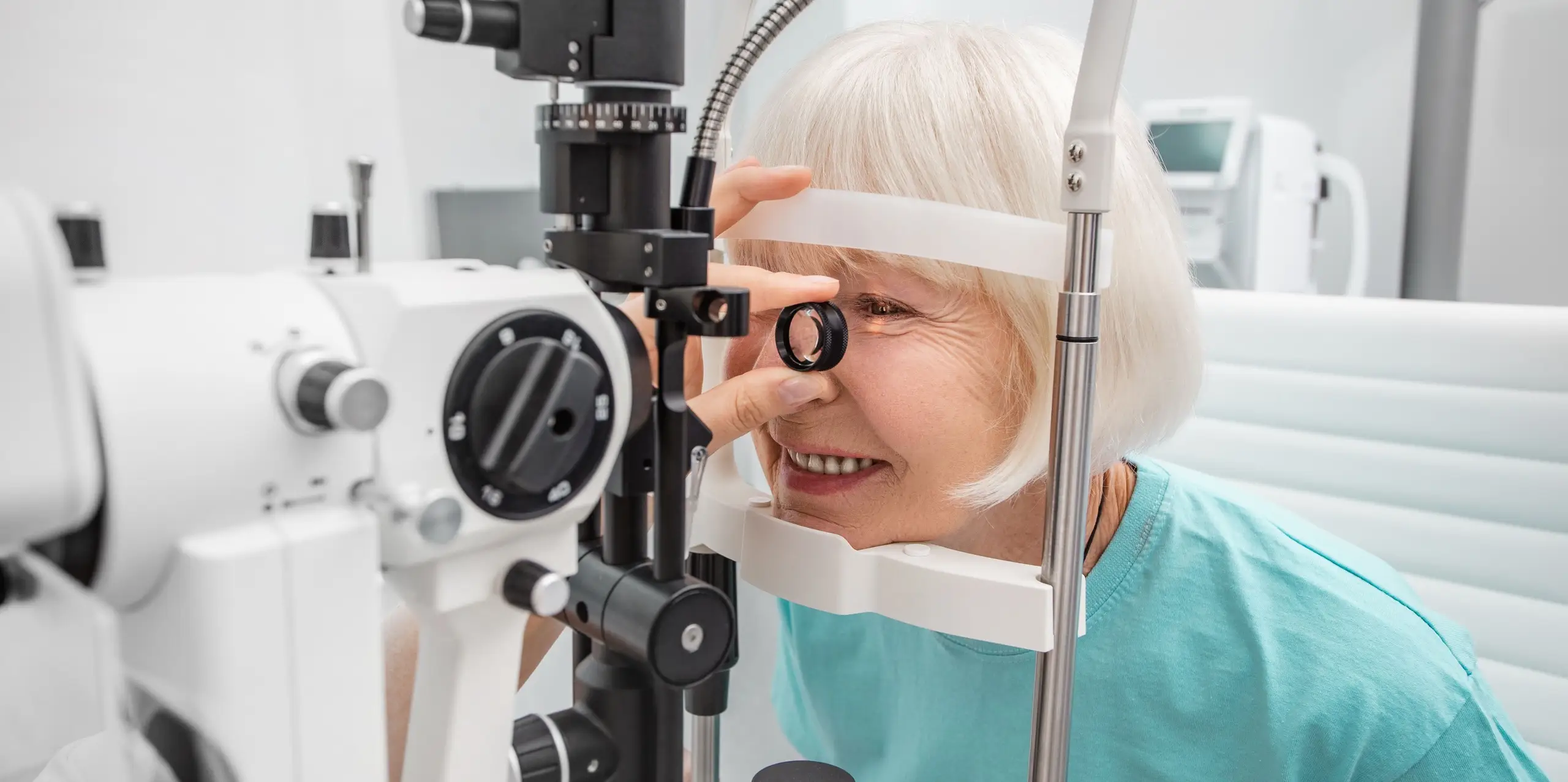Cataract Surgery
Cataracts are a common cause of blurry or distorted vision, especially as we age. At NY LASIK, we specialize in advanced cataract care, serving patients across NYC, Manhattan, Brooklyn, and the greater New York City area. Our board-certified ophthalmologists are committed to using the latest surgical techniques and technologies to restore your vision, helping you return to the activities you love with renewed clarity.

What are Cataracts?
Cataracts are a common eye condition that occurs when the eye’s natural lens, located behind the iris, becomes cloudy due to clumping proteins. This process typically begins around age 40 and gradually worsens, leading to blurred or dimmed vision. Symptoms may include difficulty seeing in low light, increased glare, and fading colors.
Cataracts are a normal part of aging. According to the National Eye Institute, up to
Trusted Source
Cataract Data and Statistics
National Eye Institute
Go to Source
50%
of Americans will develop at least one cataract by age 75. The American Academy of Ophthalmology reports that more than
Trusted Source
Eye Health Statistics
American Academy of Ophthalmology
Go to Source
20.5 million
Americans over the age of 40 currently have cataracts.

Is It Time for Cataract Surgery?
In the early stages of cataract development, many people can manage the changes in their vision by updating their glasses or contact lens prescriptions. However, this is only a temporary solution, as cataracts are a progressive condition. As the clouding of the lens worsens, it can begin to interfere with everyday activities like driving, reading, and other routine tasks.
The only definitive treatment for cataracts is surgery. While some individuals may delay surgery until their vision significantly deteriorates, it’s important to consider surgery when cataracts start to impair your quality of life. If you find that cloudy vision is making daily activities challenging, it may be time to consult an eye care specialist to discuss cataract surgery.
Don't let cataracts hold you back
Contact us to explore your treatment options.

How Cataract Surgery Works
Cataract surgery is the only definitive treatment for advanced cataracts. During this procedure, the cloudy lens of the eye is carefully removed and replaced with a clear artificial intraocular lens (IOL). This new lens not only restores clear vision but can also correct common refractive errors, reducing or even eliminating the need for eyeglasses or contact lenses after surgery.
Cataract surgery is one of the most frequently performed surgeries in the
Trusted Source
Cataract Surgery
Mayo Clinic
Go to Source
United States,
known for its high success rate and low risk of complications. By improving visual clarity, this procedure significantly enhances patients’ quality of life, allowing them to return to their daily activities without the limitations caused by cataracts.
Standard Cataract Surgery
Standard cataract surgery has seen significant advancements in recent years. Typically, the procedure involves removing the cataract through a tiny incision and replacing the cloudy natural lens with a single-focus intraocular lens (IOL). These standard lens implants often include built-in ultraviolet protection to safeguard the retina after surgery.
While standard cataract surgery can greatly improve your vision, you may still need to wear glasses for activities like reading or if you have astigmatism. This procedure is usually covered by Medicare and most medical insurance plans, but it’s essential to review your coverage details to understand what portion of the costs may be your responsibility.
Custom Cataract Surgery
While standard cataract surgery is highly effective, some patients seek an enhanced option that offers greater independence from glasses and contact lenses. Custom Cataract Surgery goes beyond the traditional approach by incorporating advanced technology and testing, including the use of advanced technology intraocular lenses (IOLs). This personalized procedure is particularly beneficial for addressing presbyopia and astigmatism, which can persist after standard surgery. It’s also an excellent choice for those who have undergone previous laser vision correction procedures like LASIK, PRK, or RK.
At our practice, we utilize the LenSx® femtosecond laser, a highly precise tool that replaces the traditional surgical blade. This laser allows for superior precision in cataract surgery, leading to improved outcomes and enhanced visual
Trusted Source
Effectiveness and safety of femtosecond laser-assisted lens fragmentation and anterior capsulotomy versus the manual technique in cataract surgery
Reddy KP, Kandulla J, Auffarth GU
Go to Source
clarity.
By choosing Custom Cataract Surgery, patients can achieve a higher level of vision correction and reduce their dependence on eyewear.
IOL Options for Cataract Surgery
Choosing the right intraocular lens implant (IOL) after cataract surgery is key to achieving your best possible vision. Several advanced IOL options are available, each designed to address different vision needs:
- Astigmatism-Correcting IOLs: These lenses correct astigmatism while improving distance vision, potentially reducing the need for glasses after surgery.
- Presbyopia-Correcting IOLs: Designed to address age-related near vision loss, these IOLs can provide clearer vision at near, intermediate, and distance ranges. Options include multifocal, trifocal, and extended depth of focus (EDOF) IOLs.
- Light Adjustable Lens™: This innovative lens allows for post-surgery customization through painless light treatments, providing precise vision correction tailored to your needs.
Your eye surgeon will guide you in choosing the right IOL for your lifestyle and vision goals.

Preparing for Cataract Surgery
Once you’ve been diagnosed with cataracts by our specialists, there are a few steps to take before your surgery. Your doctor will conduct a comprehensive eye exam and provide detailed instructions tailored to your needs. You may be asked to use specific eye drops in the days leading up to the procedure and to avoid wearing any facial lotions or makeup on the day of surgery.
Additionally, it’s important to arrange transportation to and from the clinic, as you’ll not be able to drive yourself home after the procedure.
The Cataract Surgery Procedure
Cataract surgery is typically performed on each eye separately, often within a week or two of each other. Although the procedure itself takes only about 10 to 20 minutes per eye, plan to spend a few hours at the clinic for the entire process, including admission, a physical exam, and anesthesia.
Before the surgery begins, your eye will be numbed with anesthetic drops, and a device will gently hold your eye open to prevent blinking. The surgeon will then make a small incision in the surface of your eye, through which the clouded natural lens will be broken up and removed (a process called phacoemulsification) and replaced with an artificial intraocular lens (IOL). The incision is so small that no sutures are needed; it will heal naturally on its own.
After the procedure, a protective shield will be placed over your eye. You’ll spend a brief recovery period at the clinic before being released to go home with the assistance of a friend or family member.
Cataract Surgery Recovery
Cataract surgery is an outpatient procedure, allowing you to return home the same day to begin your recovery. After surgery, you’ll need to wear a protective shield over your eye, particularly while sleeping, for the first few days. Although some patients experience slight blurriness or discomfort initially, most notice significant improvement in their vision by the next day, with continued progress over the following weeks.
Your eye doctor will prescribe anti-inflammatory and antibiotic eye drops to aid in healing and prevent infection. It’s crucial to use these drops as directed. You may also feel some mild soreness or itching, but it’s important to avoid touching or rubbing your eye during this time.
Many patients are able to resume normal activities, including driving, within 24 to 48 hours after surgery. However, you should avoid strenuous activities and swimming for about two weeks to ensure proper healing. A follow-up visit with your surgeon the day after your procedure will help monitor your recovery progress.
Yes, Medicare and most major insurance companies cover standard cataract surgery. However, they do not typically cover advanced technology IOLs, premium testing, or Custom Cataract Surgery options. Our surgical coordinators will help you review your insurance coverage, out-of-pocket expenses, and financing options during your cataract examination.
No, cataract surgery should not be painful. Your eyes will be numbed with anesthetic drops before the procedure, so you should feel no more than a slight sensation of pressure or scratchiness during surgery. Some mild soreness may be felt afterward, but pain is uncommon.
Cataract surgery is a very common and generally safe procedure, with a success rate of over >
Trusted Source
Is Cataract Surgery with Vision-Correcting IOLs Safe?
American Refractive Surgery Council
Go to Source
99%.
However, as with any surgery, there are risks, though they are rare. These may include:
- Infection
- Bleeding
- Swelling
- Retinal detachment
- Blurred vision
- Vision loss
You may be a candidate for cataract surgery if you experience persistent vision problems despite updating your glasses or contact lens prescription, notice increased glare while driving at night, have blurry vision, or struggle to see clearly during everyday tasks. A thorough eye exam with a specialist will determine your suitability for the procedure.
Cataracts cannot be prevented, but you may be able to slow their progression by:
- Protecting your eyes from UV exposure
- Maintaining a healthy diet rich in leafy greens
- Quitting smoking
- Undergoing annual comprehensive eye exams after age 60
No, cataracts cannot return after surgery since the clouded lens is removed and replaced with an artificial lens. However, some patients may develop posterior capsular opacification (PCO), also known as a “secondary cataract,” which can cause blurred vision. PCO can be easily treated with a simple, in-office laser procedure.
Cataract surgery typically takes less than 30 minutes per eye. Including preparation and post-operative observation, expect to spend 2-3 hours at the eye center on the day of your procedure.
Yes, you can still undergo cataract surgery even if you have had previous laser eye surgeries like LASIK or PRK. It’s important to provide your ophthalmologist with your full medical history to help determine the best IOL power for optimal vision correction.
You should avoid driving until your follow-up appointment, usually the day after surgery. Once your ophthalmologist confirms that your eyes have adjusted well, you can resume driving.
Cataract surgery can restore clear vision, but whether you’ll need glasses afterward depends on the type of IOL used. Standard IOLs may require you to wear glasses for certain tasks, while advanced IOLs may reduce or eliminate this need.
1 National Eye Institute. Cataract Data and Statistics. Accessed August 29, 2024.
2 American Academy of Ophthalmology. Eye Health Statistics. Available: https://www.aao.org/newsroom/eye-health-statistics#. Accessed August 29, 2024.
3 Mayo Clinic. Cataract Surgery. Available: https://www.mayoclinic.org/tests-procedures/cataract-surgery/about/pac-20384765. Accessed August 29, 2024
4 Reddy KP, Kandulla J, Auffarth GU. Effectiveness and safety of femtosecond laser-assisted lens fragmentation and anterior capsulotomy versus the manual technique in cataract surgery. J Cataract Refract Surg. 2013;39(9):1297-1306. doi:10.1016/j.jcrs.2013.05.035. Accessed August 29, 2024.
5 American Refractive Surgery Council. Is Cataract Surgery with Vision-Correcting IOLs Safe? Available: https://americanrefractivesurgerycouncil.org/refractive-surgery-procedures/cataract-surgery-with-vision-correcting-iols/is-cataract-surgery-with-vision-correcting-iols-safe. Accessed August 29, 2024.
Dr. Leonard Bley has either authored or reviewed and approved this content.